礼仪介绍英文.
《礼仪介绍英文》课件
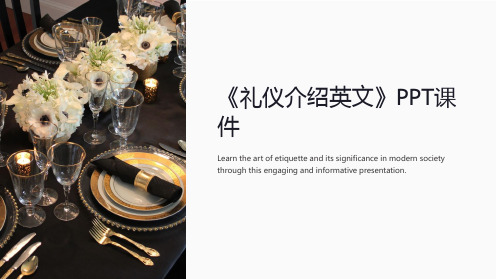
Q&A
在这个环节中,我们将回答与礼仪相关的问题,并解答其他疑惑。
关于礼仪用语
礼仪用语是社交交流中的重要组成部分。它包括礼貌用语、礼仪用语的分类 以及示例等容,有助于我们在不同场合中表达尊重和友好。
礼仪篇幅的研究
礼仪篇幅是礼仪规范中的一部分。深入研究礼仪篇幅的重要性、分类以及如 何在不同环境中灵活运用,有助于我们在社交场合中得体行事。
总结
通过本次演讲,我们了解了现代礼仪的重要性以及行为礼仪和言语礼仪的关键作用。同时,我们还给出了一些 礼仪用语示例和礼仪篇幅的研究,希望能帮助大家在社交场合中更加得体自信。
《礼仪介绍英文》PPT课 件
Learn the art of etiquette and its significance in modern society through this engaging and informative presentation.
什么是礼仪?
礼仪是社会行为准则的总称,它包括了人们在社会交往中遵循的仪式、规范和禁忌。理解礼仪的定义非常重要, 因为它能帮助我们建立良好的人际关系。
礼仪用语
问候语、道歉语、感谢语等。
言语礼仪
礼貌用语、谈话技巧、口才训练等。
礼仪篇幅
一席之地、尊重他人、合理对待时间等。
关于行为礼仪
行为礼仪是社交互动中的一门艺术。它包括的方面有礼节之道、礼仪动作、仪态端正和衣着得体等。
关于言语礼仪
言语礼仪是有效沟通的基础。它涵盖了礼貌用语、谈话技巧以及口才训练等方面,帮助我们与他人建立和谐的 关系。
礼仪的作用
礼仪在社会交往中起着重要的作用。它有助于改善个人形象,增强人际关系, 提升职场成功率,并促进文明社会的建设。
中西方餐桌礼仪 英文介绍
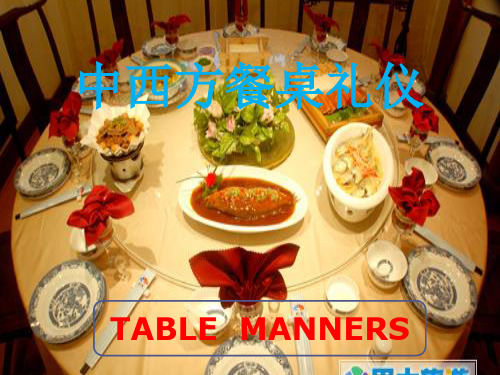
西方进餐礼仪
——餐巾篇
• 餐巾万一不小心滑下去怎么办?
西方进餐礼仪
——餐巾篇
• 想擦嘴时该怎么办? 错误:用纸巾擦。 正确:Use the napkin to gently wipe your mouth. Don’t blow your nose into your napkin 餐巾只用作轻擦嘴边。不可用来
要适时地抽空和左右的人聊几句风 趣的话,以调和气氛.不要光着头吃饭, 不管别人,也不要狼吞虎咽地大吃一顿, 更不要贪杯. 最好不要在餐桌上剔牙.如果要剔 牙时,就要用餐巾或手挡住自己的嘴巴.
西方进餐礼仪
——餐巾篇
餐巾摊开应该放何处?
Unfold the napkin and fold it half before putting it on your lap
入座位置
In CHINA
客齐后导客入席,以左为上,视为 首席,相对首座为二座,首座之下 为三座,二座之下为四座。
IN WEST
一般说来,面对门的离门最远的那个座位是女主人的,与 之相对的是男主人的座位。女主人右手边的座位是第一主宾 席,一般是位先生;男主人右边的座位是第二主宾席、一般 是主宾的夫人。女主人左边的座位是第三主宾席,男主人的 左边的座位是第四主宾席。
Put up the bowl Don't stick the chopsticks upright in the bowl.
DON’T
Slurp when drinking soup or eating noodles
喝汤和吃面条时发出声音
Keep the spoon inside the bowl or cup
Do not butter the entire piece of bread at one time
酒桌礼仪文化英文介绍

酒桌礼仪文化英文介绍全文共四篇示例,供读者参考第一篇示例:酒桌礼仪在西方国家和亚洲国家都有着悠久的历史,它是人们在聚餐时遵循的一套规范和礼仪。
在国际社交场合中,酒桌礼仪被视为一种重要的文化传统,代表着一个人的素养和修养。
以下是关于酒桌礼仪文化的英文介绍:1. Dress Code: When attending a formal dinner, it is important to dress appropriately. Men should wear a suit and tie, while women should wear a formal dress or pantsuit. Casual or overly revealing clothing is not acceptable at the dinner table.第二篇示例:Wine Table Etiquette CultureIntroductionWine table etiquette culture is an important part of dining, especially in formal settings or business gatherings. It involves rules and practices that govern the proper behavior and manners when consuming wine and dining with others. Understanding and adhering to these rules can help one navigate socialsituations more smoothly and demonstrate respect for the host and fellow guests. In this article, we will explore the key aspects of wine table etiquette culture and provide tips on how to conduct oneself appropriately at the table.Seating ArrangementsToast and Cheers第三篇示例:Wine Table Etiquette CultureWine table etiquette culture is an important aspect of dining etiquette in many cultures around the world. It involves a set of rules and customs that dictate how one should behave while drinking wine at the table. These rules are meant to ensure that the dining experience is enjoyable for everyone present and to show respect for the wine, the other guests, and the host.第四篇示例:IntroductionIn Chinese culture, the tradition of drinking at the dining table has a long history and holds an important place in social interactions. The practice of toasting, sharing drinks, and enjoying meals together is not only about consuming alcoholbut also about friendship, respect, and bonding. Understanding the etiquette and culture of the dining table is essential for anyone participating in such gatherings. In this article, we will explore the art of dining etiquette and culture in China.The Significance of Drinking at the Dining TableThe Art of ToastingDrinking EtiquetteHandling Alcohol。
礼仪介绍英文
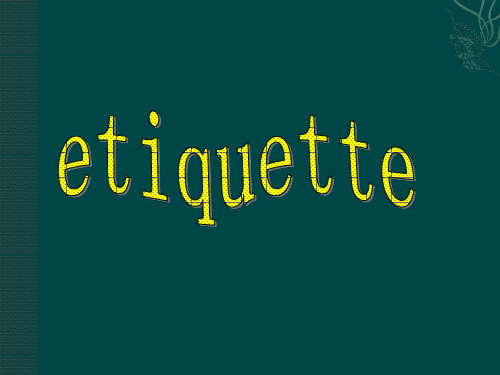
Nod ritual点头礼
点头礼一般用于平辈和 同级别的人之间,属于 比较快比较生疏的礼节。 一般两人在路上行走相 遇可以在行进中继续施 行点头礼,长官对部下、 长者对晚辈答礼也可以 用点头礼。
Nodded ceremony usually used between peers and the same level of the people, which belongs to the faster relatively unfamiliar formality. Two people walk on the road in general meeting can continue nodded ceremony in March, chief nodded ceremony to his elders to the younger generation, can also return with.
世界上有许多不同的问候方式。今天,我将向你介绍一些 问候礼仪,我希望它会做的很好,你们所有的人。
Oriental Etiquette
In China
Our country has a long history for about 5,ooo years . In ancient times, people had lots of different ways of greetings when they met with each others .
China classical etiquette 1.Bow with hands clasped 揖: 拱手行礼,是为揖。这是古代 宾主相见的最常见的礼节。揖 让之礼分为三种:
First:专用于没有婚姻关系的 异姓,行礼时推手微向下;
中国的礼仪文化英语作文(12篇)
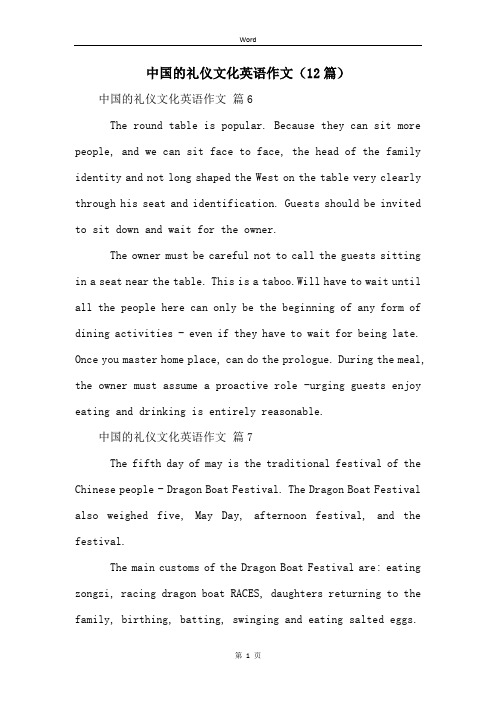
中国的礼仪文化英语作文(12篇)中国的礼仪文化英语作文篇6The round table is popular. Because they can sit more people, and we can sit face to face, the head of the family identity and not long shaped the West on the table very clearly through his seat and identification. Guests should be invited to sit down and wait for the owner.The owner must be careful not to call the guests sitting in a seat near the table. This is a taboo.Will have to wait until all the people here can only be the beginning of any form of dining activities - even if they have to wait for being late. Once you master home place, can do the prologue. During the meal, the owner must assume a proactive role -urging guests enjoy eating and drinking is entirely reasonable.中国的礼仪文化英语作文篇7The fifth day of may is the traditional festival of the Chinese people - Dragon Boat Festival. The Dragon Boat Festival also weighed five, May Day, afternoon festival, and the festival.The main customs of the Dragon Boat Festival are: eating zongzi, racing dragon boat RACES, daughters returning to the family, birthing, batting, swinging and eating salted eggs.The origin of the Dragon Boat Festival is to commemorate the great patriotic poet qu yuan.When making zongzi, they can wrap different shapes such as triangles, circles, squares and rectangles. Zongzi is salty, sweet and peanut.The dragon boat race is because the ship can save the great patriotic poet qu yuan, the other is because of the fear that jiaolong harm qu yuans body, people can drive a boat to beat the gong, to drive away the flood dragon. Every year in May, there are dragon boat RACES.This is the traditional Chinese festival, Dragon Boat Festival. I love Dragon Boat Festival!中国的礼仪文化英语作文篇8Table manners in China Different country have different table manners.The western country is different from eastern country,such as China and France.In China,old people eat first.We aren’t supposed to talk aloud while we are eating.If you don’t want to eat next,you are supposed to say: I’m full. And you aren’t supposed to eat fruit at once.Chinese eat food with chopsticks.It is rude if you point at someone with your chopsticks.All of them will be helpful to you.It can make you a politeperson.So we must know more about the manners around the world.中国的礼仪文化英语作文篇9The Dragon Boat Festival, also called the Duanwu Festival, is celebrated on the fifth day of the fifth month according to the Chinese calendar. People always eat rice dumplings and watch dragon boat races to celebrate it. The festival is best known for its dragon-boat races, especially in the southern places where there are many rivers and lakes. It’s very popular. The rice dumpling is made of glutinous rice, meat and so on. You can eat different kinds of rice dumplings. They are very delicious. And Dragon Boat Festival is for Qu Yuan. He is an honest minister who is said to have committed by drowning himself in a river. Overall, the Dragon Boat Festival is very interesting! the Middle-Autumn Festival The Middle-Autumn Festival is one of the traditional Chinese festivals, it is often held in September or October. During the festival, family members get united and have moon cakes together. There are various kinds of moon cakes, such as bean paste, egg-yolk or meat. The shape of a moon cake is round as it symbolizes a big moon. Moreover, in the evening of the Middle-Autumn Festival, people get together in a vacant place, eating delicious moon cakes while appreciating the beautiful moon hanging in the darksky. To conclude, the Middle-Autumn Festival is a very nice festival for Chinese people. Last Qing Ming Festival, I return home to worship my grandfather. Qing Ming Festival is a folk Festival. In the past, In the past, the Qing Ming Festival was called Arbor Day.But Today, Chinese visit their family graves to tend to any underbrush that has grown. Weeds are pulled, and dirt swept away, and the family will set out offerings of food and spirit money. Unlike the sacrifices at a familys home altar, the offerings at the tomb usually consist of dry, bland food.One theory is that since any number of ghosts roomed around a grave area, the less appealing food will be consumed by the ancestors, and not be plundered by strangers. With the passing of time, this celebration of life became a day to the honor past ancestors. Following folk religion, the Chinese believed that the spirits of deceased ancestors looked after the family. Sacrifices of food and spirit money could keep them happy, and the family would prosper through good harvests and more children. Chinese Spring Festival celebrating the end of winter and the warmth of spring. It began in the last day of the lunar year, ends in the 15th day of lunar New Year, and also is the Lantern Festival. During the Spring Festival, people use redlantern and Spring Festival couplets decorate a house, put on all kinds of colored clothes, often visit friendsand relatives or together eat dumplings, fish, meat and other delicious food. The children are looking forward to receiving red envelope money, and together they play each other the fireworks, with happy. Street with dragonand lion dance and some other carnival activities,CCTV will held the grand Spring Festival gala. Lantern Festival is a China’s traditional festival. It is celebrated on the fifteenth day of the first month of the lunar ntern Festival is one of the biggest holidays in China. Several days before Lantern Festival, people begin to make lanterns. Lanterns are made in the shape of different animals, vegetables, fruits and many, other things. While making lanterns people usually write riddles on lanterns. On the eve of Lantern Festival, all the lanterns are hung up.On Lantern Festival people go outside to have a look at the lanterns and guess the riddles on the lanterns. Perhaps you call see some wonderful folk performances, Dragon Dance and New Younger. Everything is very interesting and everyone is very happy. Our life is rich and varied.中国的礼仪文化英语作文篇10Table manners in China Different country have differenttable manners.The western country is different from eastern country,such as China and France.In China,old people eat first.We aren’t supposed to talk aloud while we are eating.If you don’t want to eat next,you are supposed to say I’m full. And you aren’t supposed to eat fruit at once.Chinese eat food with chopsticks.It is rude if you point at someone with your chopsticks.All of them will be helpful to you.It can make you a polite person.So we must know more about the manners around the world.中国的礼仪文化英语作文篇11Today is Dragon Boat Festival, the weather is unexpectedly good. Early in the morning, my parents and I went to the spirit lake in high spirits. I have heard that there are dragon-boat RACES here. I look forward to it!At the linghu pier, I saw wang recalled qian and her mother. They are sorry to tell me that the dragon-boat race has just finished! However, after a while, I hear that there will be another match. Wang and I will play and wait.After a while, the dragon boat race finally began! At this time, Chen hao yu and his mother, Yang shuyu and her father and mother also like to come. On the calm surface of the lake, two slender dragon boats were lined up, and the boat people weredressed in red and yellow and ready to go. As the referee whistled, two dragon boats scrambled to set out. On the dragon boat, the players shouted slogans, and in line with the drums, they rowed hard, and you chased me. Two beautiful water marks were drawn in the back of the dragon boat, and the scene was spectacular! The audience on the pier cheered for them!中国的礼仪文化英语作文篇12Today is the Dragon Boat Festival, early in the morning, mother will call us up and I sat rubbing his eyes, mother took out a lot of sachets, give everyone wear, I bring is pink zongzi shape of sachets.Let me talk about the origin of the Dragon Boat Festival. Is that of the fifth lunar month, is the day of qu yuan jumped jiang, because qu yuan is the minister of the king huai nice but he said to king huai huai would not listen to them, as a result of qu yuan felt useless, finally jump river, the river was called the miluo river. In this way, people have a custom to play dragon boat race, because the villagers think qu yuan is patriotic to row the dragon boat to pursue qu yuan, but cant catch up. Also eat mung bean cake, eat zongzi, drink realgar wine, the custom of planting mugwort on the door, also bring confetti, sachets and so on.This morning, my father and I went to buy mugwort. We didnt buy it. It was too late. We bought oil cakes. We went to grandpas grandmothers house, and really did eat zongzi, mung bean cake, oil cake, no realgar wine, not drinking, and wearing the color line, especially happy. Ha ha!。
中国的礼仪礼节英文作文_专业真题英语作文4篇
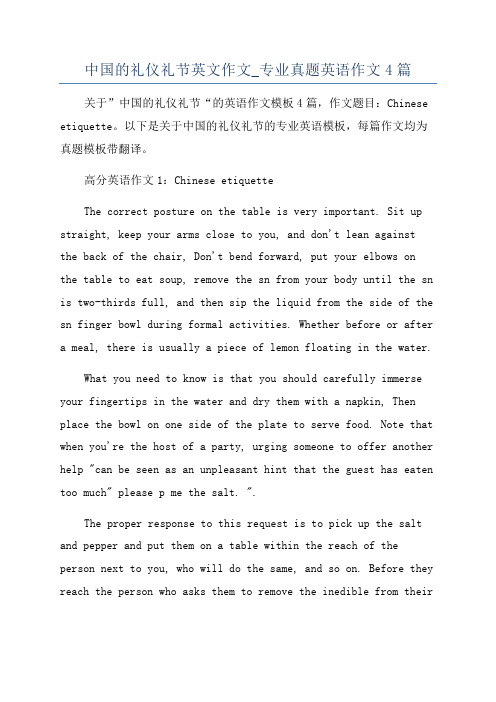
中国的礼仪礼节英文作文_专业真题英语作文4篇关于”中国的礼仪礼节“的英语作文模板4篇,作文题目:Chinese etiquette。
以下是关于中国的礼仪礼节的专业英语模板,每篇作文均为真题模板带翻译。
高分英语作文1:Chinese etiquetteThe correct posture on the table is very important. Sit up straight, keep your arms close to you, and don't lean against the back of the chair, Don't bend forward, put your elbows on the table to eat soup, remove the sn from your body until the sn is two-thirds full, and then sip the liquid from the side of the sn finger bowl during formal activities. Whether before or after a meal, there is usually a piece of lemon floating in the water.What you need to know is that you should carefully immerse your fingertips in the water and dry them with a napkin, Then place the bowl on one side of the plate to serve food. Note that when you're the host of a party, urging someone to offer another help "can be seen as an unpleasant hint that the guest has eaten too much" please p me the salt. ".The proper response to this request is to pick up the salt and pepper and put them on a table within the reach of the person next to you, who will do the same, and so on. Before they reach the person who asks them to remove the inedible from theirmouth, the general rule of removing food from the mouth is that the food should flow out in the same way.中文翻译:餐桌小贴士开始有两种常见的方法来决定如何在小型活动中开始,通常等到餐桌上的每个人都收到了一份食物,而女主人已经开始吃东西,这是很常见的。
中国餐桌礼仪英文介绍
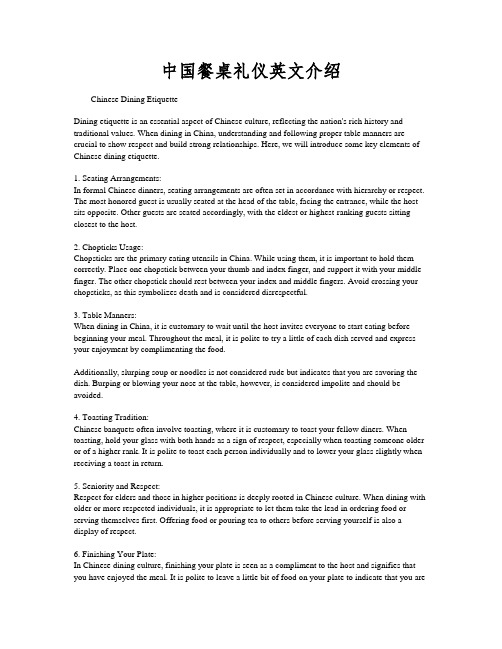
中国餐桌礼仪英文介绍Chinese Dining EtiquetteDining etiquette is an essential aspect of Chinese culture, reflecting the nation's rich history and traditional values. When dining in China, understanding and following proper table manners are crucial to show respect and build strong relationships. Here, we will introduce some key elements of Chinese dining etiquette.1. Seating Arrangements:In formal Chinese dinners, seating arrangements are often set in accordance with hierarchy or respect. The most honored guest is usually seated at the head of the table, facing the entrance, while the host sits opposite. Other guests are seated accordingly, with the eldest or highest-ranking guests sitting closest to the host.2. Chopticks Usage:Chopsticks are the primary eating utensils in China. While using them, it is important to hold them correctly. Place one chopstick between your thumb and index finger, and support it with your middle finger. The other chopstick should rest between your index and middle fingers. Avoid crossing your chopsticks, as this symbolizes death and is considered disrespectful.3. Table Manners:When dining in China, it is customary to wait until the host invites everyone to start eating before beginning your meal. Throughout the meal, it is polite to try a little of each dish served and express your enjoyment by complimenting the food.Additionally, slurping soup or noodles is not considered rude but indicates that you are savoring the dish. Burping or blowing your nose at the table, however, is considered impolite and should be avoided.4. Toasting Tradition:Chinese banquets often involve toasting, where it is customary to toast your fellow diners. When toasting, hold your glass with both hands as a sign of respect, especially when toasting someone older or of a higher rank. It is polite to toast each person individually and to lower your glass slightly when receiving a toast in return.5. Seniority and Respect:Respect for elders and those in higher positions is deeply rooted in Chinese culture. When dining with older or more respected individuals, it is appropriate to let them take the lead in ordering food or serving themselves first. Offering food or pouring tea to others before serving yourself is also a display of respect.6. Finishing Your Plate:In Chinese dining culture, finishing your plate is seen as a compliment to the host and signifies that you have enjoyed the meal. It is polite to leave a little bit of food on your plate to indicate that you aresufficiently satisfied.By following these Chinese dining etiquettes, you will not only show respect for the Chinese culture but also enhance your dining experience by enjoying the delicious cuisine. Remember, Chinese dining is not just about the food; it is about harmonious social interactions and building friendships.。
用餐礼仪介绍英语作文

用餐礼仪介绍英语作文Dining Etiquette。
As we all know, dining etiquette is an important part of our social skills. It reflects our manners and shows respect to others. Here are some tips for proper dining etiquette.1. Dress appropriately. Dress according to the occasion and the restaurant's dress code. Avoid wearing casual clothes like shorts, flip flops, and tank tops to formal restaurants.2. Wait to be seated. When entering a restaurant, wait to be seated by the host or hostess. If you have a reservation, let them know your name and the number of people in your party.3. Napkin placement. Place the napkin on your lap as soon as you sit down. If you need to leave the tabletemporarily, place the napkin on your chair.4. Utensil usage. Use the utensils from the outside in, starting with the salad fork. The knife should be held in the right hand and the fork in the left hand. When finished, place the utensils parallel to each other on the plate.5. Bread and butter. Use the bread plate to hold your bread and butter. Break off a small piece of bread andbutter it one piece at a time.6. Drinking etiquette. Hold the wine glass by the stem, not the bowl. If you are not drinking alcohol, place your glass on the right side of the water glass.7. Conversation. Keep the conversation light and polite. Avoid discussing sensitive topics like politics and religion. Do not talk with your mouth full.8. Paying the bill. If you are the host, pay the bill discreetly. If you are a guest, offer to pay your share or leave a tip.In conclusion, proper dining etiquette is important for making a good impression and showing respect to others. By following these tips, we can enjoy a pleasant dining experience with our friends and colleagues.。
中国礼仪英文10条简短
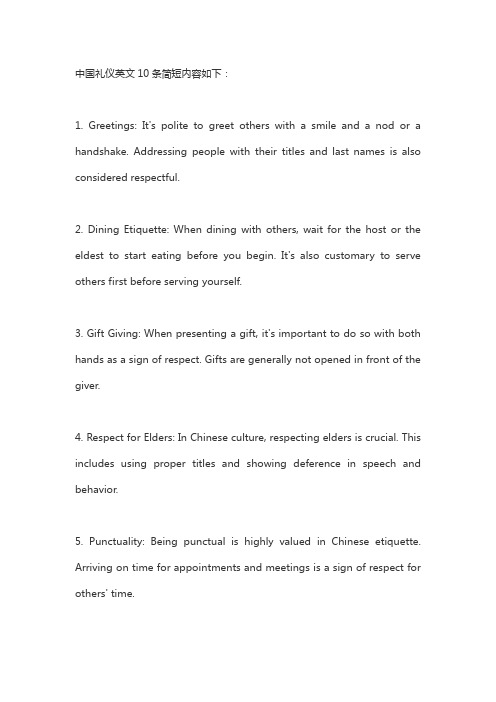
中国礼仪英文10条简短内容如下:1. Greetings: It's polite to greet others with a smile and a nod or a handshake. Addressing people with their titles and last names is also considered respectful.2. Dining Etiquette: When dining with others, wait for the host or the eldest to start eating before you begin. It's also customary to serve others first before serving yourself.3. Gift Giving: When presenting a gift, it's important to do so with both hands as a sign of respect. Gifts are generally not opened in front of the giver.4. Respect for Elders: In Chinese culture, respecting elders is crucial. This includes using proper titles and showing deference in speech and behavior.5. Punctuality: Being punctual is highly valued in Chinese etiquette. Arriving on time for appointments and meetings is a sign of respect for others' time.6. Use of Chopsticks: When using chopsticks, avoid sticking them upright in a bowl of rice, as this symbolizes death and is considered impolite.7. Proper Attire: Dressing modestly and conservatively is important, especially in formal settings and when visiting religious sites.8. Public Behavior: Maintaining composure in public places and refraining from loud or disruptive behavior is a sign of respect for others.9. Personal Space: Respecting personal space is important. Avoid standing too close to others and be mindful of physical boundaries.10. Farewells: When leaving a gathering or meeting, it's customary to bid farewell to each person individually to show respect and gratitude for their company.。
英文介绍中国基本礼仪作文

英文介绍中国基本礼仪作文英文:Chinese basic etiquette is an important aspect of Chinese culture, and it plays a significant role in social interactions and relationships. As a Chinese person, I have been brought up with a strong emphasis on the importance of etiquette in our daily lives. 。
One of the most fundamental aspects of Chineseetiquette is showing respect to others, especially to elders and those in positions of authority. This is often demonstrated through various gestures and greetings. For example, when meeting someone for the first time, it is customary to offer a polite greeting, such as "Nǐ hǎo" (你好) which means "hello" in Chinese, along with a slight bow or nod of the head. Additionally, addressing someone with their proper title and using polite language is also crucial in showing respect.Another important aspect of Chinese etiquette is the concept of "saving face," which means avoiding causing embarrassment or loss of dignity to oneself or others. For instance, it is considered impolite to openly criticize or confront someone in public, as it may cause them to lose face. Instead, issues are often addressed in a morediscreet and indirect manner, in order to preserve harmony and avoid causing discomfort to others.Furthermore, the practice of offering and receiving gifts is an integral part of Chinese etiquette. When giving a gift, it is important to present it with both hands as a sign of respect, and the recipient is expected to receive the gift with both hands as well. This simple gesture demonstrates appreciation and gratitude for the gesture. Additionally, it is customary to refuse a gift at least once before accepting it, as a way of showing humility and modesty.In addition to these examples, there are numerous other customs and traditions that are observed in Chinese etiquette, such as the proper use of chopsticks, seatingarrangements at a dining table, and the way business cards are exchanged. These customs may vary in different regionsof China, but the underlying principles of respect, harmony, and humility remain consistent throughout the country.中文:中国的基本礼仪是中国文化的重要组成部分,在社会交往和人际关系中起着重要作用。
介绍礼仪的英语作文

介绍礼仪的英语作文Title: Introduction to Etiquette。
Etiquette is a set of rules and customs that govern social behavior and interactions. It plays a crucial rolein shaping individuals' characters and influencing their relationships with others. In this article, we will explore the significance of etiquette and its various aspects.First and foremost, etiquette is essential for creating a harmonious and respectful social environment. By adhering to proper etiquette, individuals can demonstrate their consideration and respect for others, leading to smoother and more pleasant interactions. For example, using polite language, showing good manners, and being mindful of personal space are all important components of etiquette that contribute to positive social dynamics.Moreover, etiquette is a reflection of one's upbringing and character. People who display good manners and adhereto social norms are often perceived as polite, respectful, and considerate. This can have a positive impact on their personal and professional relationships, as others are more likely to trust and respect individuals who demonstrate proper etiquette.In addition, etiquette varies across different cultures and social settings. What may be considered polite in one culture could be perceived as rude in another. Therefore,it is important for individuals to be aware of theetiquette norms in various contexts, especially in multicultural and diverse environments. By understanding and respecting different etiquette practices, individuals can avoid misunderstandings and show appreciation for cultural diversity.Furthermore, etiquette encompasses various aspects of social behavior, including communication, dining, and personal interactions. In terms of communication, using appropriate language, maintaining eye contact, and being attentive to others are all important aspects of etiquette. When it comes to dining, knowing how to use utensils,observing table manners, and showing appreciation for the host's hospitality are essential components of dining etiquette. In personal interactions, respecting personal boundaries, offering assistance when needed, and expressing gratitude are all key elements of etiquette.It is worth noting that etiquette is not static and can evolve over time. As society changes and new social norms emerge, etiquette may also adapt to reflect these changes. For example, the rise of digital communication has led to the development of online etiquette, which governs behavior in virtual spaces such as social media and email.In conclusion, etiquette plays a crucial role in shaping social interactions and individuals' characters. By adhering to proper etiquette, individuals can create a respectful and harmonious social environment, demonstrate their upbringing and character, and navigate diverse cultural settings with ease. It is important forindividuals to be mindful of etiquette norms and to adapt to evolving social dynamics in order to foster positive and meaningful relationships with others.。
简单介绍中国礼仪英文作文
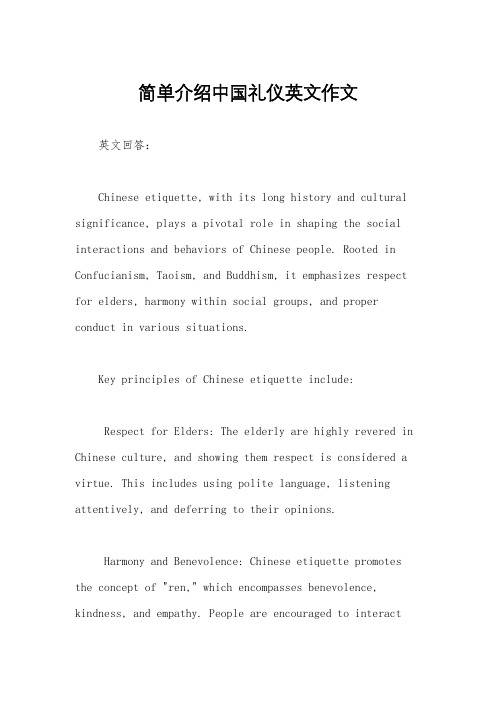
简单介绍中国礼仪英文作文英文回答:Chinese etiquette, with its long history and cultural significance, plays a pivotal role in shaping the social interactions and behaviors of Chinese people. Rooted in Confucianism, Taoism, and Buddhism, it emphasizes respect for elders, harmony within social groups, and proper conduct in various situations.Key principles of Chinese etiquette include:Respect for Elders: The elderly are highly revered in Chinese culture, and showing them respect is considered a virtue. This includes using polite language, listening attentively, and deferring to their opinions.Harmony and Benevolence: Chinese etiquette promotes the concept of "ren," which encompasses benevolence, kindness, and empathy. People are encouraged to interactwith each other in a respectful and harmonious manner, avoiding confrontations and conflicts.Appropriate Behavior: Different social contexts demand different forms of behavior. For example, at formal events, people are expected to dress appropriately, speak politely, and follow established rules of conduct.Gift-Giving Etiquette: Giving and receiving gifts is an important part of Chinese etiquette. Gifts are often chosen carefully to express respect, appreciation, or good wishes. It is customary to present gifts with both hands and to accept them with gratitude.Dining Etiquette: Mealtimes hold cultural significance in China. Etiquette dictates that meals be shared, and guests are often encouraged to take the best portions. Elders and guests of honor are usually seated at the head of the table.Nonverbal Communication: Nonverbal cues play a significant role in Chinese etiquette. Gestures, facialexpressions, and eye contact can convey subtle messages.For example, maintaining eye contact with someone who is speaking is considered a sign of respect.中文回答:中国礼仪历史悠久,文化底蕴深厚,在中国人的社会交往和行为举止中起着至关重要的作用。
介绍中国礼仪英文作文
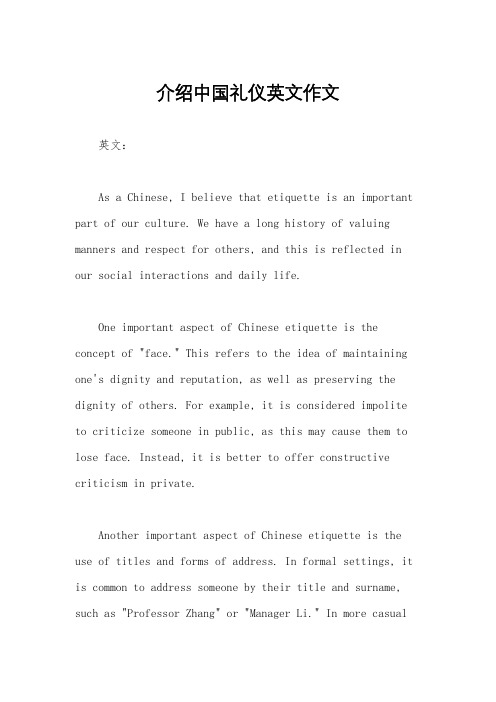
介绍中国礼仪英文作文英文:As a Chinese, I believe that etiquette is an important part of our culture. We have a long history of valuing manners and respect for others, and this is reflected in our social interactions and daily life.One important aspect of Chinese etiquette is the concept of "face." This refers to the idea of maintaining one's dignity and reputation, as well as preserving the dignity of others. For example, it is considered impolite to criticize someone in public, as this may cause them to lose face. Instead, it is better to offer constructive criticism in private.Another important aspect of Chinese etiquette is the use of titles and forms of address. In formal settings, it is common to address someone by their title and surname, such as "Professor Zhang" or "Manager Li." In more casualsettings, it is acceptable to use a person's given name, but it is still important to show respect by using appropriate titles and honorifics.In addition, gift-giving is an important part of Chinese etiquette. When visiting someone's home or attending a special occasion, it is customary to bring a small gift as a token of appreciation. The gift should be appropriate to the occasion and should not be too expensive or extravagant.Overall, Chinese etiquette emphasizes the importance of showing respect for others and maintaining harmony insocial situations. By following these customs, we can strengthen our relationships and build a more cohesive society.中文:作为一名中国人,我相信礼仪是我们文化的重要组成部分。
关于礼仪英文作文

关于礼仪英文作文1. When it comes to etiquette, it's all about showing respect and consideration for others. Whether it's saying "please" and "thank you," holding the door open for someone, or simply being polite, good manners go a long way in making others feel valued and appreciated.2. In some cultures, it's customary to bow whengreeting someone, while in others, a firm handshake is the norm. Understanding and respecting these culturaldifferences is an important aspect of etiquette, as it shows that you are aware and respectful of others' customs and traditions.3. When dining with others, it's important to follow proper table manners. This includes using utensils appropriately, chewing with your mouth closed, and not reaching across the table for food. By demonstrating good table manners, you show that you are considerate of others and mindful of your behavior in a social setting.4. Etiquette also extends to communication, whether in person or through technology. It's important to listen attentively when someone is speaking, avoid interrupting, and be mindful of your tone and language when communicating. Additionally, using proper grammar and spelling in written communication shows respect for the recipient.5. Another aspect of etiquette is being punctual. Whether it's for a meeting, appointment, or social gathering, being on time shows that you value and respect others' time. It also demonstrates reliability and responsibility, which are important qualities in any social or professional setting.6. Finally, showing gratitude is an important part of etiquette. Whether it's sending a thank-you note,expressing appreciation in person, or simply acknowledging someone's kindness, taking the time to show gratitude is a meaningful way to show respect and consideration for others.7. Overall, etiquette is about showing respect,consideration, and mindfulness in our interactions with others. By being aware of and practicing good manners, we can create a more positive and respectful environment for everyone.。
英语公德礼仪的英文介绍~~15页PPT文档

Mottos On Manners
Who pleasure gives,shall joy receive. If you ride a horse,sit close and tight;if you ride a man,sit
easy and light When you're good to others,you are best to yourself. What is serving God?'Tis doing good to man.
Presentation
主讲人 :顾馨文 张添莹
Something About Courtesy
Do you know the meaning of courtesy? What actions do you think can be regarded as
polite ? What is the importance of courtesy?
We are the main force in the construction of the motherland and jointly charged with an important mission to create a better future. Let us start from now on,remember to be more polite whenever and wherever you are.
Personal qualities
school family society individual
Do you have other point of view?
Solutions
Attention should be paid to our own moral self-cultivation
介绍礼仪的演讲稿英文

介绍礼仪的演讲稿英文Good morning, ladies and gentlemen. Today, I am honored to have this opportunity to talk to you about the importance of etiquette.Etiquette, or good manners, is an essential part of our daily lives. It is the way we show respect and consideration for others, and it plays a crucial role in building positive relationships and creating a harmonious society.First and foremost, etiquette is important in our personal interactions. When we practice good manners, we show others that we value and respect them. Simple gestures such as saying "please" and "thank you," holding the door for someone, or giving up your seat on public transportation, can go a long way in making others feel appreciated and acknowledged.Moreover, etiquette is also crucial in professional settings. In the workplace, good manners can help to create a positive and productive environment. This includes being punctual, dressing appropriately, and communicating respectfully with colleagues and clients. These small actions can make a big difference in how we are perceived and can contribute to our success in the workplace.Furthermore, etiquette is important in social situations. Whether we are at a formal event or a casual gathering, practicing good manners can help to create a pleasant and enjoyable atmosphere for everyone. This includes being mindful of our behavior, showing consideration for others, and being gracious and polite in our interactions.In addition, etiquette is also important in the digital age. With the rise of social media and online communication, it is important to remember that good manners extend to our online interactions as well. This includes being mindful of our language and tone, respecting others' privacy, and being considerate of others' feelings in our online interactions.In conclusion, etiquette is an essential part of our lives, and it is important to remember that good manners are not just a set of rules to follow, but a way of showingrespect and consideration for others. By practicing good manners in our personal interactions, professional settings, social situations, and online communication, we can contribute to creating a more positive and harmonious society.Thank you for your attention. Let us all strive to be mindful of our etiquette and to treat others with kindness and respect in all aspects of our lives.。
中国礼仪介绍英文作文
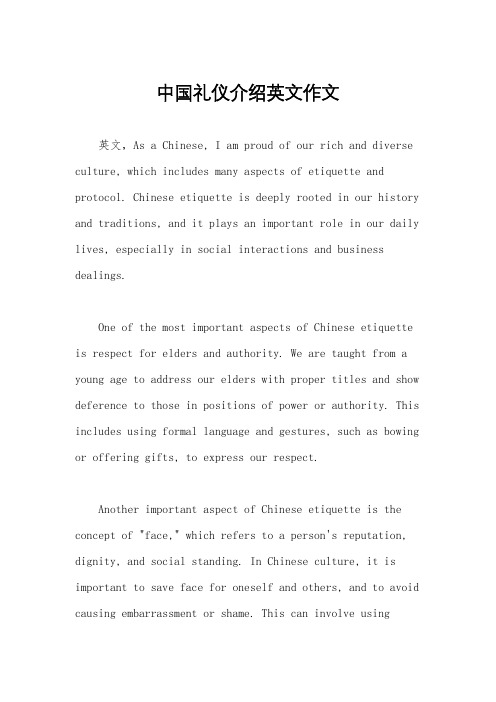
中国礼仪介绍英文作文英文,As a Chinese, I am proud of our rich and diverse culture, which includes many aspects of etiquette and protocol. Chinese etiquette is deeply rooted in our history and traditions, and it plays an important role in our daily lives, especially in social interactions and business dealings.One of the most important aspects of Chinese etiquette is respect for elders and authority. We are taught from a young age to address our elders with proper titles and show deference to those in positions of power or authority. This includes using formal language and gestures, such as bowing or offering gifts, to express our respect.Another important aspect of Chinese etiquette is the concept of "face," which refers to a person's reputation, dignity, and social standing. In Chinese culture, it is important to save face for oneself and others, and to avoid causing embarrassment or shame. This can involve usingindirect language or gestures to communicate, or avoiding certain topics or actions that may be considered impoliteor inappropriate.In addition, gift-giving is an important part of Chinese etiquette, particularly in business settings. It is customary to bring a small gift when visiting someone's home or office, and to offer gifts to business partners or clients as a sign of respect and goodwill. However, it is important to choose appropriate gifts and avoid giving anything that may be seen as too extravagant or inappropriate.Overall, Chinese etiquette is a complex and nuanced system that reflects our cultural values and traditions. By following these customs and showing respect for others, we can build strong relationships and foster mutual understanding.中文,作为一个中国人,我为我们丰富多彩的文化而感到自豪,其中包括许多礼仪和协议方面。
- 1、下载文档前请自行甄别文档内容的完整性,平台不提供额外的编辑、内容补充、找答案等附加服务。
- 2、"仅部分预览"的文档,不可在线预览部分如存在完整性等问题,可反馈申请退款(可完整预览的文档不适用该条件!)。
- 3、如文档侵犯您的权益,请联系客服反馈,我们会尽快为您处理(人工客服工作时间:9:00-18:30)。
Nod ritual点头礼
点头礼一般用于平辈和 同级别的人之间,属于 比较快比较生疏的礼节。 一般两人在路上行走相 遇可以在行进中继续施 行点头礼,长官对部下、 长者对晚辈答礼也可以 用点头礼。
Nodded ceremony usually used between peers and the same level of the people, which belongs to the faster relatively unfamiliar formality. Two people walk on the road in general meeting can continue nodded ceremony in March, chief nodded ceremony to his elders to the younger generation, can also return with.
4.拜:古代表示恭敬的一种礼节。古之拜,只是拱手弯腰而已, 两手在胸前合抱,头向前俯,额触双手,如同揖。如《孔雀东 南飞》中的“上堂拜阿母,阿母怒不止”,这儿的“拜”就是 焦仲卿对母亲行的这种礼节。后来亦指将屈膝顿首、两手着地 或叩头及地称为“拜”。 5.拜手:古代的一种跪拜礼。行礼时,跪下,两手拱合到地,头 靠在手上。《周礼》中作“空首”;也作“拜首”。 6.再拜:拜两次为再拜,表示礼节之隆重。如“谨使臣良奉白璧 一双,再拜献大王足下”(《鸿门宴》)。过去书信末尾也常 用“再拜”以表示敬意。
There are many different ways of greetings in the world . Today , I will introduce you some greeting manners , and I hope it will do good to all of you .
Western Etiquette
Because of the difference customs between countries to countries, their etiquettes are not identical . Handshake ritual 握手礼 起源于欧洲,现已流行 世界。一般客人先伸手, 双方有一人是女性时, 女方先伸手。握手礼一 般不戴手套,但十分尊 贵的人和女性可以戴手 套。
世界上有许多不同的问候方式。今天,我将向你介绍一些 问候礼仪,我希望它会做的很好,你们所有的人。
Oriental Etiquette
In China
Our country has a long history for about 5,ooo years . In ancient times, people had lots of different ways of greetings when they met with each others .
上级与下级,上级先伸手; 职位高者与职位低者,职位 高者先伸手; 长辈与晚辈,长辈先伸手; 男女见面,女士先伸手; 主宾见面,主人先伸手; 主客分别,客人先伸手; 已婚妇女与未婚小姐,已婚 女性先伸手
When handshake: Don't wear gloves 不能戴着手套; Don't look around; 不能东张西望; After, Cannot use a handkerchief hand 握手后不能用手帕擦手;
7.顿首:跪而头叩地为顿首。“顿”是稍停的意思。行礼时, 头碰地即起,因其头接触地面时间短暂,故称顿首。通常用于 下对上及平辈间的敬礼。如官僚间的拜迎、拜送,民间的拜贺、 拜望、拜别等。也常用于书信的开头或末尾。如“……丘迟顿 首”(《与陈伯之书》)。 8.稽首:古代的一种跪拜礼。 跪而头触地作较长时间停留为 稽首。“稽”是停留拖延的意思。行礼时,施礼者屈膝跪地, 左手按右手,拱手于地,头也缓缓至于地,手在膝前,头在手 后。头在地必须停留一段时间。稽首是最重的礼节,常为臣子 拜见君王时所用。
China classical etiquett e 2. make a low bow and withdraw 长揖,这是古代不 分尊卑的相见礼,Hand held high, from the top to the bottom. 拱手高举,自上而下 。 3. Hands on his chest 拱: 古代的一种相见礼,两手在胸 前相合表示敬意。如“子路拱 而立”(《论语》)。
Introduction
and
Greetings
In order to leave a good impression by others , it is necessary for us to learn how to greet to people we meet in a correct way. 为了给他人留下好的印象,这是我们必须学习如何迎接我 们以正确的方式满足。
China classical etiquette 1.Bow with hands clasped 揖: 拱手行礼,是为揖。这是古代 宾主相见的最常见的礼节。揖 让之礼分为三种:
First:专用于没有婚姻关系的 异姓,行礼时推手微向下;
Second:专用于有婚姻关系的异 姓,行礼时推手平而致于前; Third:ຫໍສະໝຸດ 用于同姓宾客,行礼 时推手微向上。
Originated in Europe, has been popular in the world. General guests before hand, both sides have a person is a woman, a woman's hand first. Handshake generally do not wear gloves, but very noble men and women can wear gloves.
